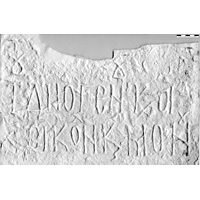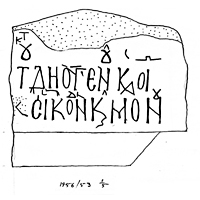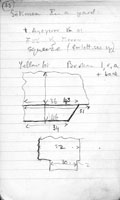 MAMA XI 61 (Eumeneia)
MAMA XI 61 (Eumeneia) 
Building inscription, possibly of Romanos IV Diogenes
- Type of monument:
- Building inscription.
- Location:
- Sökmen (Eumeneia): in a yard.
- Description:
- Shaped block of yellow limestone, broken left, right, above and behind.
- Dimensions:
- Ht. 0.46+; W. 0.51+; Th. 0.52; letters 0.042-0.075.
- Record:
- Line drawing; squeeze; MB notebook copy (1956/53).
- Publication:
- None.
- Date:
- Eleventh or twelfth century AD (letter forms)
[- - -] τοῦ Δηογένου(ς) κ(αὶ) ΟΙ[- - -]
[- - -]. οἰκοδ(ομὴ)ν Κ() μονου [- - -]






The lettering of the inscription and the abundant use of abbreviations and diacritics suggest a date in the eleventh or twelfth century AD; compare the lettering and layout of Feissel 1987: 432, no. 52 (AD 1176).
In line 2, I have taken the abbreviation ΟΙΚΟΔ`Ν to represent οἰκοδ(ομὴ)ν, ‘construction’. Assuming that the stone is part of a building inscription rather than a tombstone, two possible historical contexts might be suggested. First, in AD 1192, the fortress of Choma in the upper Maeander valley was reconstructed by Isaac II Angelos and renamed Angelokastron (Ahrweiler 1966; TIB Phrygien 222, s.v. Chōma; on the location of Choma (probably very close to the site of ancient Eumeneia), see Thonemann 2011a, Chapter 4. Second, an unpublished inscription dated to AD 1070/1 records the reconstruction of a kastron at a fortified höyük in the upper Maeander plain south-east of Işıklı. The 1070/1 inscription is referred to by Foss 1982: 153, and by Belke and Mersich, TIB Phrygien 252, s.v. Eumeneia, who quote a single phrase from it: ‘[ἀνεκ]ενήσθ(η) ἐκ βάθρω(ν) τὼ θ(ε)οφύλακτ(ον) κάστρον...’. A precisely contemporaneous inscription (dated to AD 1069/70) records the reconstruction of the fortress of Sozopolis (Uluborlu, ancient Apollonia by Pisidia) by the emperor Romanos IV Diogenes: [ἀνεκαινίσθη τὸ κάστρ]ον Σοζοπόλεος ἐπὴ Ῥομανοῦ [αὐτοκράτορος Ῥομέων τοῦ Δ]ιογένους ἐν ἔτη τῶ σφοη΄ (MAMA IV 149; Foss 1982: 153-7).
It is tempting, therefore, to restore line 1 of our inscription [- - ἐπὶ Ῥωμανοῦ] τοῦ Δηογένου(ς), and to assume that it refers to the same building-works as those commemorated in the 1070/1 inscription from the höyük near Işıklı. Since the latter inscription remains unpublished, it is hard to say whether it could be another fragment of the same monument.